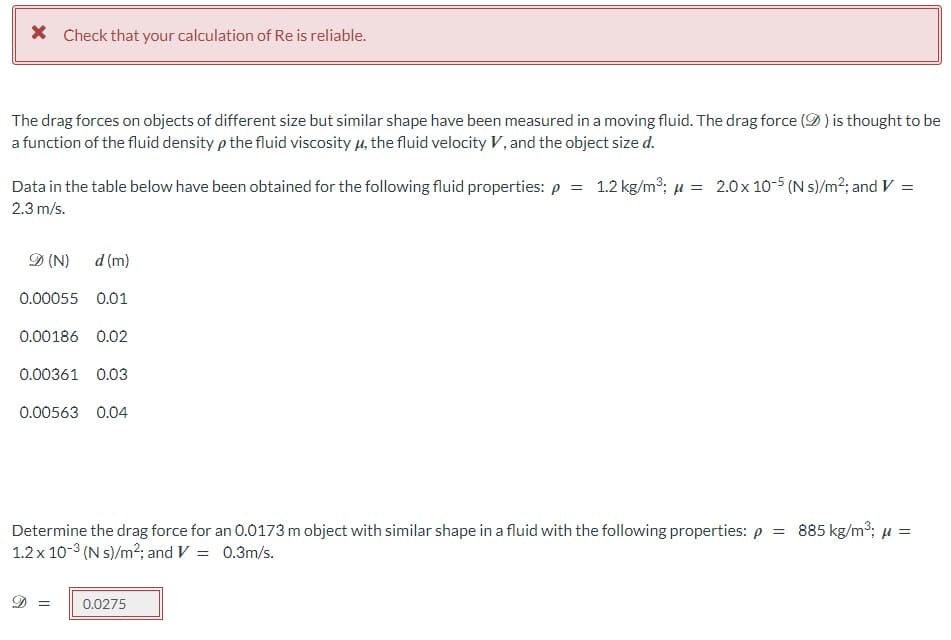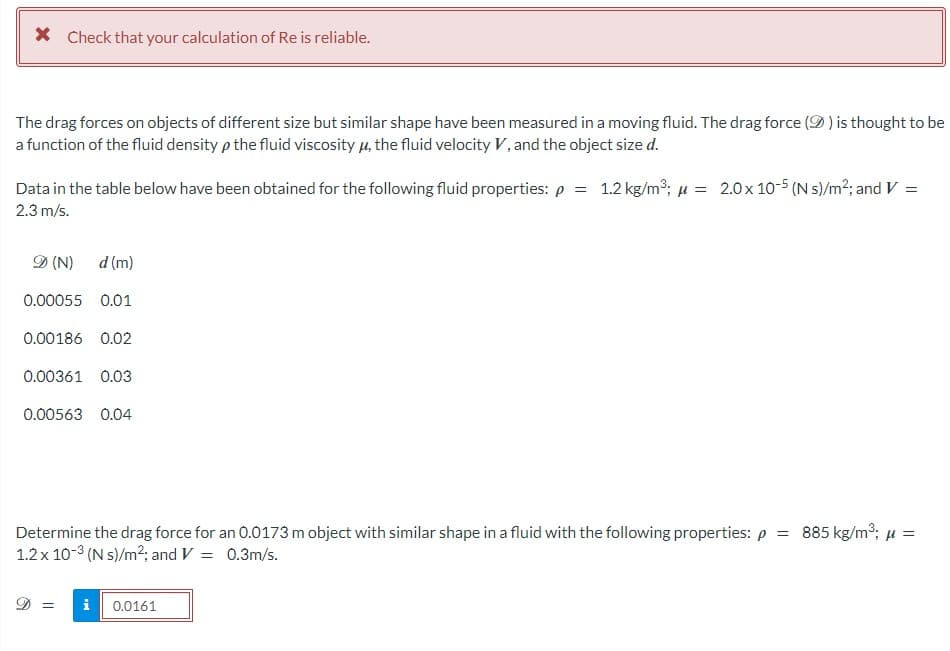I need help correcting this problem (incorrect attempts are attached). Please step-by-step.
I need help correcting this problem (incorrect attempts are attached). Please step-by-step.
Principles of Heat Transfer (Activate Learning with these NEW titles from Engineering!)
8th Edition
ISBN:9781305387102
Author:Kreith, Frank; Manglik, Raj M.
Publisher:Kreith, Frank; Manglik, Raj M.
Chapter5: Analysis Of Convection Heat Transfer
Section: Chapter Questions
Problem 5.18P: The drag on an airplane wing in flight is known to be a function of the density of air (), the...
Related questions
Question
I need help correcting this problem (incorrect attempts are attached). Please step-by-step.

Transcribed Image Text:* Check that your calculation of Re is reliable.
The drag forces on objects of different size but similar shape have been measured in a moving fluid. The drag force () is thought to be
a function of the fluid density p the fluid viscosity μ, the fluid velocity V, and the object size d.
Data in the table below have been obtained for the following fluid properties: p = 1.2 kg/m³; μ = 2.0 x 10-5 (N s)/m²; and V =
2.3 m/s.
D (N)
d (m)
0.00055 0.01
0.00186 0.02
0.00361 0.03
0.00563 0.04
Determine the drag force for an 0.0173 m object with similar shape in a fluid with the following properties: p = 885 kg/m³; μ =
1.2 x 10-³ (N s)/m²; and V = 0.3m/s.
D =
0.0275

Transcribed Image Text:* Check that your calculation of Re is reliable.
The drag forces on objects of different size but similar shape have been measured in a moving fluid. The drag force () is thought to be
a function of the fluid density p the fluid viscosity μ, the fluid velocity V, and the object size d.
Data in the table below have been obtained for the following fluid properties: p = 1.2 kg/m³; μ = 2.0 x 10-5 (N s)/m²; and V =
2.3 m/s.
(N)
d (m)
0.00055 0.01
0.00186 0.02
0.00361 0.03
0.00563 0.04
Determine the drag force for an 0.0173 m object with similar shape in a fluid with the following properties: p = 885 kg/m³; µ =
1.2 x 10-3 (N s)/m²; and V = 0.3m/s.
D = i 0.0161
Expert Solution
This question has been solved!
Explore an expertly crafted, step-by-step solution for a thorough understanding of key concepts.
This is a popular solution!
Trending now
This is a popular solution!
Step by step
Solved in 4 steps with 18 images

Knowledge Booster
Learn more about
Need a deep-dive on the concept behind this application? Look no further. Learn more about this topic, mechanical-engineering and related others by exploring similar questions and additional content below.Recommended textbooks for you

Principles of Heat Transfer (Activate Learning wi…
Mechanical Engineering
ISBN:
9781305387102
Author:
Kreith, Frank; Manglik, Raj M.
Publisher:
Cengage Learning

Principles of Heat Transfer (Activate Learning wi…
Mechanical Engineering
ISBN:
9781305387102
Author:
Kreith, Frank; Manglik, Raj M.
Publisher:
Cengage Learning